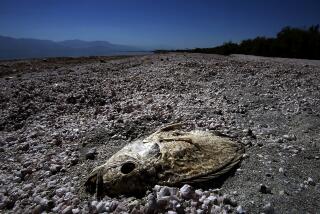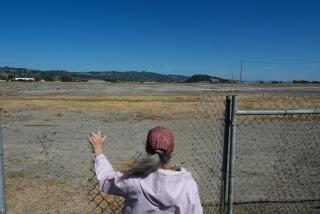Hong Kong Tackles Filthy Victoria Harbor, Once Exotic Jewel of Orient : Asia: It’s beautiful from a distance, but up close it’s a floating garbage pit. Massive quantities of chemicals, human waste and agricultural byproducts are the principal pollutants.
HONG KONG — From a distance, Victoria Harbor is a place of exotic beauty. White skyscrapers gleam above its blue waters, which bustle with vessels of every description. It’s the best deep-water port on the China coast.
Up close, it’s a floating dump. Hong Kong’s Marine Department picks up an average of 17 tons of trash a day. But that isn’t the greatest threat to the British crown colony’s human and animal life.
“Rubbish may be unsightly,” said Michael Stocko, assistant director of the Environmental Protection Department, “but bacteria, industrial waste and heavy metals cause far more harm.”
Massive quantities of chemicals, human waste and agricultural byproducts such as pig excrement are the principal pollutants in Hong Kong’s waters. The government estimates that about half the sewage flows directly into the South China Sea.
Some of the rest passes through pipes that carry both rainwater and sewage. The heavily polluted water contaminates seafood, a dietary staple here, as in most of Asia.
For the last 50 years, the problem has largely been ignored. But now, alarmed by the threat of catastrophic disease in the congested but fast-growing colony, authorities have launched both a $1.55-billion cleanup of Victoria Harbor and a fivefold expansion of its port.
Whether the projects will be completed by Hong Kong’s new Communist rulers is one of many questions to be answered after the colony becomes part of the People’s Republic of China in 1997.
In the late 1980s, industrial pollution from Shatin New Town in the New Territories led to “red tides”--an influx of damaging marine organisms--with devastating destruction of marine life in one of the channels running into the South China Sea.
Last year, a cholera outbreak sent a disagreeable warning to the more than 6 million residents of Hong Kong. They occupy only 10% of the colony’s 413 square miles, making parts of the Kowloon Peninsula and Hong Kong Island among the world’s most crowded real estate. The colony also encompasses the New Territories, abutting the mainland, and 235 other islands.
The land keeps growing, at the harbor’s expense. When all planned reclamation projects are finished, led by a huge new international airport, Victoria Harbor will be reduced by an area almost half the size of New York City’s Manhattan Island. By early in the next century, according to government documents, the harbor will be 36.5% smaller than it was 150 years ago.
Great Britain occupied Hong Kong in 1839, and China ceded the territory to Britain in 1841. Overshadowed by Shanghai for its first century, the colony started prospering after the Communist takeover of China in 1949.
Today, the capitalist community is the world’s third-largest financial center and its 11th-largest trading economy. Its container-shipping port is the world’s second-busiest.
Hong Kong consumes more cognac, per capita, and has more Rolls-Royces, per acre, than any other place on Earth.
Despite such prosperity, the accelerating deterioration of Victoria Harbor and the accompanying threat to future development have spurred both the Hong Kong government and the public to action. The Environmental Protection Department staff has grown from 150 to 1,500 since the agency’s creation in 1986.
More than a dozen local and international “green” groups are involved in a range of environmental issues. “Educated people in Hong Kong are concerned about conservation now,” said Stocko. “Public expectations and interest have grown, in part as a result of an increase in disposable income.” Hong Kong’s annual per-capita income of $11,500 is second only to Japan’s in East Asia.
The first of two stages in the Victoria Harbor cleanup is scheduled for completion in 1997, the second a few years later.
Both involve better primary treatment of sewage, which would improve public health and make Hong Kong’s harbor safe for recreation. But critics say that the cleanup will not go far enough. The Chinese government questions its cost-effectiveness and claims there are serious health risks in discharging treated effluent into the sea.
“Although primary treatment would make the water meet Hong Kong’s safety standards, it doesn’t reduce nutrient load as much as it should,” said John Hodgkiss, a member of the colony’s new Department of Ecology and Biodiversity, and a former dean of the science faculty at Hong Kong University.
As if Hong Kong’s water problems weren’t already daunting, construction of the new airport, one of the largest engineering projects in the world, is expected to generate about 320 million cubic yards of waste mud in the next five years.
Mixed in with this, nearly 34 million cubic yards of toxic mud containing titanium, lead, cadmium, PCPs and other elements are being buried in undersea pits dredged in shallow water off Lantau Island. Although the government maintains that the pits are an effective, safe method of disposing of the mud, environmental groups remain concerned.
“Fishermen are still fishing near toxic-mud dumps, where shellfish are potentially contaminated,” said Joanna Ruxton, senior conservation officer of the Worldwide Fund for Nature Hong Kong.
Although Stocko acknowledges that the quantity of mud is “quite shocking,” he counters that Environmental Protection Department water sampling has shown no adverse effects from the pits.
Cooperation with China is essential if the long-term cleanup is to succeed.
“It is daft to look at Hong Kong individually when it is part of the entire area of the Pearl River Delta,” said Hodgkiss. “There has been some cooperation with China, but Hong Kong needs to strengthen and develop that relationship.”
More to Read
Sign up for Essential California
The most important California stories and recommendations in your inbox every morning.
You may occasionally receive promotional content from the Los Angeles Times.










